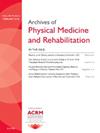Four-Year Trajectories of Symptoms and Quality of Life in Individuals Hospitalized After Mild Traumatic Brain Injury
IF 3.6
2区 医学
Q1 REHABILITATION
Archives of physical medicine and rehabilitation
Pub Date : 2025-03-01
DOI:10.1016/j.apmr.2024.09.005
引用次数: 0
Abstract
Objectives
To (1) detect distinct trajectories of symptoms and quality of life (QoL) over the first 4 years after mild traumatic brain injury (mTBI); (2) assess the relationship between symptom trajectory membership and QoL trajectory membership; and (3) identify participant characteristics associated with QoL trajectory membership.
Design
Prospective longitudinal cohort study. Assessments occurred at 4, 8, 12, 24, 36, and 48 months after mTBI.
Setting
Recruitment occurred in Level 1 Trauma Centers; follow-up was completed in the community.
Participants
Participants were 143 adults (aged 18-65y) who sustained an mTBI and were hospitalized (≥24h) at a Level 1 Trauma Center.
Interventions
Not applicable.
Main Outcome Measures
Fatigue Severity Scale, Hospital Anxiety and Depression Scale, Insomnia Severity Index, Medical Outcomes Study Cognitive Functioning Scale, Quality of Life after Brain Injury questionnaire, presence/absence of headaches or dizziness.
Results
Group-based trajectory modeling revealed relatively stable symptom and QoL trajectories over time. Considerable percentages of participants were classified in trajectories of clinically significant symptoms throughout the full follow-up period: 62% for subjective cognitive issues, 54% for fatigue, 44% for anxiety, 43% for insomnia, 27% for depression, 23% for headaches, and 17% for dizziness. Sixty-six percent of participants belonged to trajectories of persistently poor QoL. For all symptoms, trajectories of greater severity were associated with trajectories of poorer QoL. None of the sociodemographic or injury-related variables examined were associated with QoL trajectory membership.
Conclusions
A substantial proportion of individuals hospitalized after mTBI experiences clinically significant persistent symptoms ≤4 years after injury, and those with more severe symptoms have poorer QoL. Further research is required to better understand the factors leading to symptom persistence and poor QoL.
轻度脑外伤住院患者四年的症状和生活质量轨迹。
目标1)检测轻度创伤性脑损伤(mTBI)后最初四年中症状和生活质量(QoL)的不同轨迹;2)评估症状轨迹成员与QoL轨迹成员之间的关系;3)确定与QoL轨迹成员相关的参与者特征:设计:前瞻性纵向队列研究。评估时间为创伤后 4、8、12、24、36 和 48 个月:研究地点:一级创伤中心;随访在社区完成:参与者:143名成年人(18至65岁),他们遭受了mTBI并在一级创伤中心住院(至少24小时):不适用 主要结局测量:疲劳严重程度量表、医院焦虑和抑郁量表、失眠严重程度指数、医疗结果研究认知功能量表、脑损伤后生活质量问卷、有无头痛或头晕 结果:基于群体的轨迹建模显示,随着时间的推移,症状和生活质量轨迹相对稳定。在整个随访期间,相当大比例的参与者被归类为具有临床意义的症状轨迹:主观认知问题占 62%,疲劳占 54%,焦虑占 44%,失眠占 43%,抑郁占 27%,头痛占 23%,头晕占 17%。66%的参与者的生活质量持续低下。在所有症状中,严重程度越高的症状轨迹与 QoL 越低的轨迹越相关。所研究的社会人口学或受伤相关变量均与 QoL 轨迹无关:结论:mTBI 后住院的患者中,有相当一部分人在伤后四年内会出现临床上明显的持续症状,而症状更严重的患者 QoL 更差。要更好地了解导致症状持续存在和 QoL 较差的因素,还需要进一步的研究。
本文章由计算机程序翻译,如有差异,请以英文原文为准。
求助全文
约1分钟内获得全文
求助全文
来源期刊
CiteScore
6.20
自引率
4.70%
发文量
495
审稿时长
38 days
期刊介绍:
The Archives of Physical Medicine and Rehabilitation publishes original, peer-reviewed research and clinical reports on important trends and developments in physical medicine and rehabilitation and related fields. This international journal brings researchers and clinicians authoritative information on the therapeutic utilization of physical, behavioral and pharmaceutical agents in providing comprehensive care for individuals with chronic illness and disabilities.
Archives began publication in 1920, publishes monthly, and is the official journal of the American Congress of Rehabilitation Medicine. Its papers are cited more often than any other rehabilitation journal.

 求助内容:
求助内容: 应助结果提醒方式:
应助结果提醒方式:


